|
|
![]()
FOREST HEALTH - HARDWOOD STEM & TRUNK DISEASES
The rich vascular tissue in the live portion of trunks and branches lies under the bark. Cellulose-rich wood lies inside the vascular tissue. These tissues are the target of a large number of pathogens and wood-rotting fungi. Symptoms are commonly the wilting of leaves or fruiting bodies (e.g. conks) outside the bark. Some are relatively harmless to the trees, while others are fatal. Many diseases degrade wood quality and result in the loss of billions of dollars of monetary value each year. Disease is, by far, the top cause of tree mortality. Biologically, many of these diseases are interesting and are an essential component of a healthy forest ecosystem. Wood rotting fungi provide habitat for a large number of insects, birds, mammals, and other wildlife. Some are even edible. On the other hand, certain exotic species have wreaked havoc on our eastern forests, and there are more to come. Red text indicates an exotic pest.
| Armillaria Aspen Shoot Blight Ash Dieback Beech Bark Disease Black Knot of Cherry |
Butternut Canker Chestnut Blight Dutch Elm Disease Eutypella Canker Hickory Decline |
Hypoxylon Canker Oak Wilt Sapstreak in Sugar Maple Trunk Rots Verticillium Wilt |
| Armillaria (Armillaria mellea et al.): a very common soil fungus that invades stressed and dead trees, usually considered a root rot, sometimes called 'shoestring rot' after the strands of fungal tissue under dried-out bark, edible fruiting bodies sometimes called 'honey mushrooms', this is the 'humungous fungus' of Crystal Falls, can be responsible for mortality of individual trees within plantations | ||
| Hosts: most tree species | ||
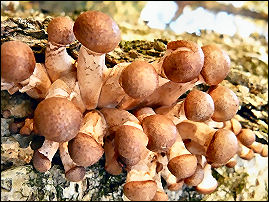 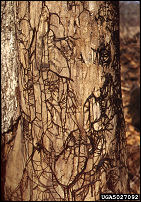 |
||
Aspen Shoot Blight (Venturia tremulae, V. populina): leaf spots and shoot death can plague regenerating stands of balsam poplar and aspen, shoot bends over in a 'shepard's crook' shape, leaves can turn dark brown or black, affects current year growth only, usually not a serious pest but can be quite noticeable at times |
||
| Hosts: balsam poplar, quaking aspen, bigtooth aspen | ||
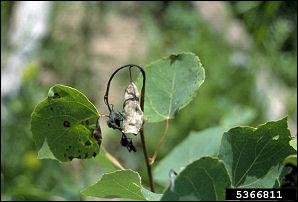 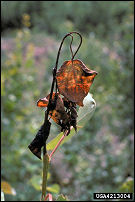 |
||
Ash Dieback (Candidatus Phytoplasma fraxini, Cytophoma pruinosa, Fusicoccum spp.): the cause is not fully understood but involves a fungus and a phytoplasm (kind of bacteria), weather is a significant factor, especially drought, symptoms similar to those of emerald ash borer infestations (top-down death, epicormic branching, stump shoots, etc.), crowns thin and form tufts |
||
| Hosts: mostly white ash, sometimes green ash | ||
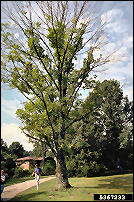 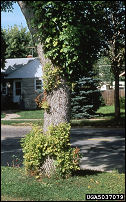 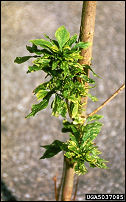 |
||
Beech Bark Disease (Nectria spp. + scale insect): a combination of insect and fungus, it's the Nectria fungi that typically kills the tree, introduced around 1890 but only within the last decade (or so) have killed much of the beech in Michigan, scales infest a tree and then introduce the Nectria which kills the tree, 'tar spots' are first indications of Nectria presence, often trees 'snap' at weak spots in the trunk caused by the fungus |
||
| Hosts: American beech | ||
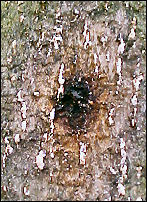 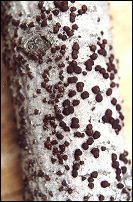 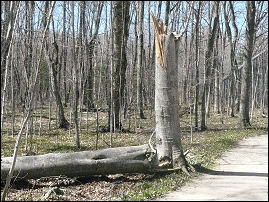 [white-waxy scales & tar spot, Nectria fruiting bodies, beech 'snap'] |
||
Black Knot of Cherry (Apiosporina morbosa): an easy to identify disease, forms black-crusty growths on twigs and branches, can appear like charcoal, sometimes reaches main stem, not usually fatal but can be unsightly to some people, some growths can become several feet long |
||
| Hosts: cherries, juneberries | ||
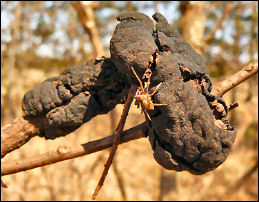 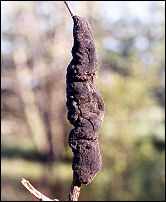 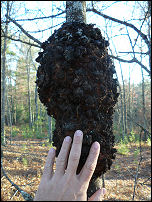 |
||
Butternut Canker (Sirrococcus clavigignenti-juglandacearum): gradually killing much of the US butternut resource, tree species survival at risk, appears as crown loss and leaf clustering, epicormic branching (new sprouts from stems/branches), canker cracks eventually appear on stems and large branches, native vs. exotic debate, first noted in the 1960s |
||
| Hosts: butternut (Juglans cinerea) | ||
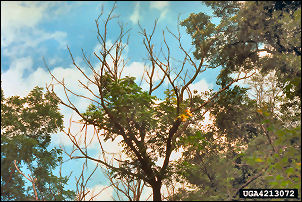 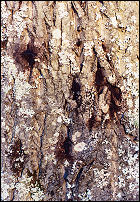 |
||
| Chestnut Blight (Cryphonectria parasitica): this disease dramatically changed the composition of eastern forests, chestnut used to be one of the most common and valuable forest trees, not had a serious impact in Michigan and especially the UP because chestnut was not so common this far west, worthy of note because of the tremendous change caused by the this exotic disease, introduced in 1904 | ||
| Hosts: American chestnut (Castanea dentata) | ||
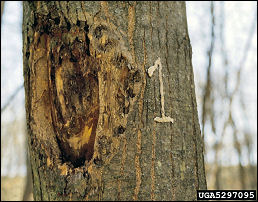 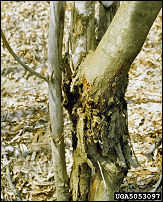 |
||
Dutch Elm Disease (Ceratocystis ulmi): a vascular disease that results in browning and leaf loss that might occur throughout a growing season and sometimes multiple growing seasons, it often begins with the yellowing of the leaves on a single branch (called flagging), transmission is via bark beetles (Scolytus multistriatus), usually trees must be 10+ inches in diameter, most large diameter elms have died, this loss is most noticable in residential areas where streets were once lined with large graceful elms |
||
| Hosts: commonly American and slippery (red) elm although all native elms are vulnerable | ||
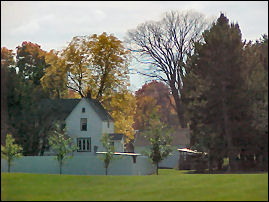 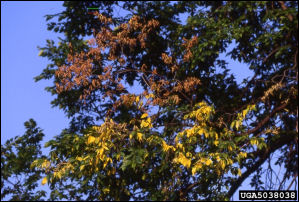 |
||
Eutypella Canker (Eutypella parasitica): a common fungus in northern hardwoods, especially maple trees, introduced through a wound, thick callus growths result over time, sometimes swellings are large and oddly shaped, often follows sugar maple borer injury |
||
| Hosts: maples, especially sugar maple | ||
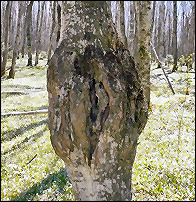 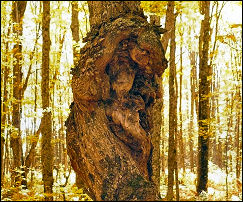 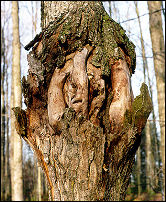 |
||
Hickory Decline (Ceratocystis caryae, C. smalleyi): most of the UP hickory (mostly bitternut hickory) is located along the rivers and floodplains of Lake Michigan rivers, especially the Menominee River, the fungus causes long oval stains in the sapwood, often associated with a bark beetle (Scolytus quadrispinosus), severe spring drought stress in 2010 led to massive mortality from bark beetles and canker (to a lesser extent) |
||
| Hosts: hickories | ||
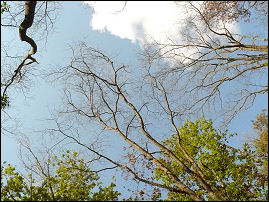 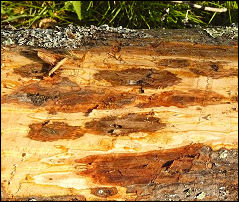 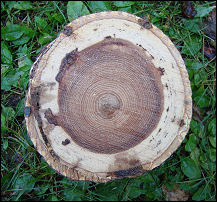 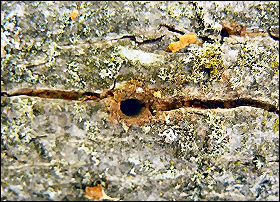 |
||
Hypoxylon Canker (Hypoxylon mammatum): a common disease of aspens, enters through wounds (Saperda beetles common wound-maker) cankers are sunken and colored a greenish-orange, older cankers have peeling bark and near black underneath, aspen often break at canker locations, severe infestations can kill entire stands |
||
| Hosts: quaking aspen most susceptible, bigtooth aspen | ||
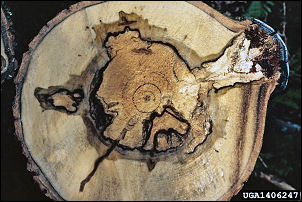 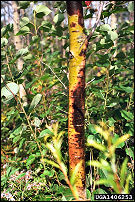 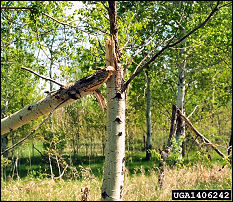 |
||
Oak Wilt (Ceratocystis fagacearum): biologically, oak wilt is a vascular disease that results in browning and leaf loss within a period of several weeks (which is considered quick), it can be mistaken for a leaf disease, leaves can brown & curl within 2-3 weeks at almost anytime during the growing season but more commonly occurs in the late spring / early summer, wilt begins at the tree top and works downward, trees in the red oak group commonly have root grafts that expedite disease spread, overland transmission occurs via sap-feeding beetles and probably a number of other vectors, avoid damaging/pruning oaks from May through August |
||
| Hosts: all oaks but oaks in the red oak group are most susceptible and succumb the quickest | ||
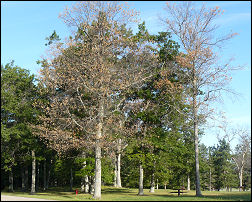 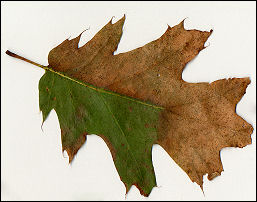 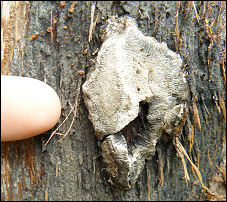 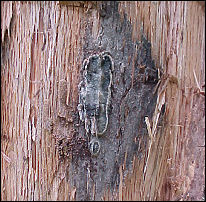 |
||
Sapstreak of Sugar Maple (Ceratocystis coerulescens): not common but it is fatal, infected tree produces small than normal leaves, gradual decline, crown begins to dieback, some Michigan locations identified |
||
| Hosts: sugar maple | ||
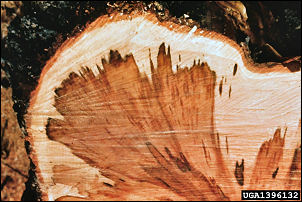 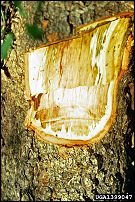 |
||
Trunks Rots: there are many fungal species that decay wood and eventually produce a conk (fruiting body), conks usually indicated an advanced state of internal decay (especially in aspen), many trunk rots are specific to particular tree species, some tree species can 'wall off' the rot and others cannot, trees cannot heal wounds and subsequent rot - they can only isolate and grow over them, some fruiting bodies are edible, artist conks are valuable in the craft industry |
||
| Hosts: all tree species | ||
|
||
Verticillium Wilt (Verticillium albo-atrum): a soil-borne fungus that moves through a trees vascular system, may affect only a portion of a tree or the entire tree, trees often recover if the infection is small and the tree is otherwise healthy, can occur at any time in growing season, |
||
Hosts: many tree species but especially maples |
||
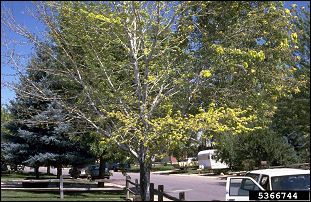 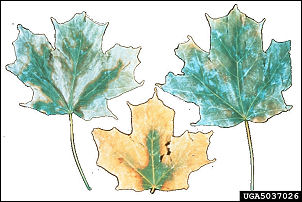 |
||
Image Citations
Armillaria (2) - Joseph O'Brien, USDA Forest Service, Bugwood.org
Aspen Shoot Blight (1) - William Jacobi, Colorado State University, Bugwood.org
Aspen Shoot Blight (2) - Minnesota Department of Natural Resources Archive, Minnesota Department of Natural Resources, Bugwood.org
Ash Dieback (1), Ash Yellows -
William Jacobi, Colorado State University, Bugwood.org
Ash Dieback (2, 3) - USDA Forest Service - Forest Health Protection - St. Paul Archive, USDA Forest Service, Bugwood.org
Butternut Canker (1) - Minnesota Department of Natural Resources Archive, Minnesota Department of Natural Resources, Bugwood.org
Chestnut Blight (1, 2) - Joseph O'Brien, USDA Forest Service, Bugwood.org
Dutch Elm Disease (2) - Joseph O'Brien, USDA Forest Service, Bugwood.org
Hickory Canker (3) - Bob Heyd, Michigan DNRE
Hypoxylon Canker (1-3) - USDA Forest Service - North Central Research Station Archive, USDA Forest Service, Bugwood.org
Maple Sapstreak (1) - USDA Forest Service - Northeastern Area Archive, USDA Forest Service, Bugwood.org
Maple Sapstreak (2) - Manfred Mielke, USDA Forest Service, Bugwood.org
Verticillium (1) - William Jacobi, Colorado State University, Bugwood.org
Verticillium (1) - Joseph O'Brien, USDA Forest Service, Bugwood.org
All others - Bill Cook, Michigan State University Extension
Click HERE
to return to the U.P. Tree ID home page.
Click HERE to return to the Forest Health home page.
This site created and maintained by Bill Cook, MSU Extension Forester for the Upper Peninsula of Michigan. Editing and modification is ongoing. Submit suggestions, questions, and corrections to cookwi@msu.edu or call 906-786-1575.